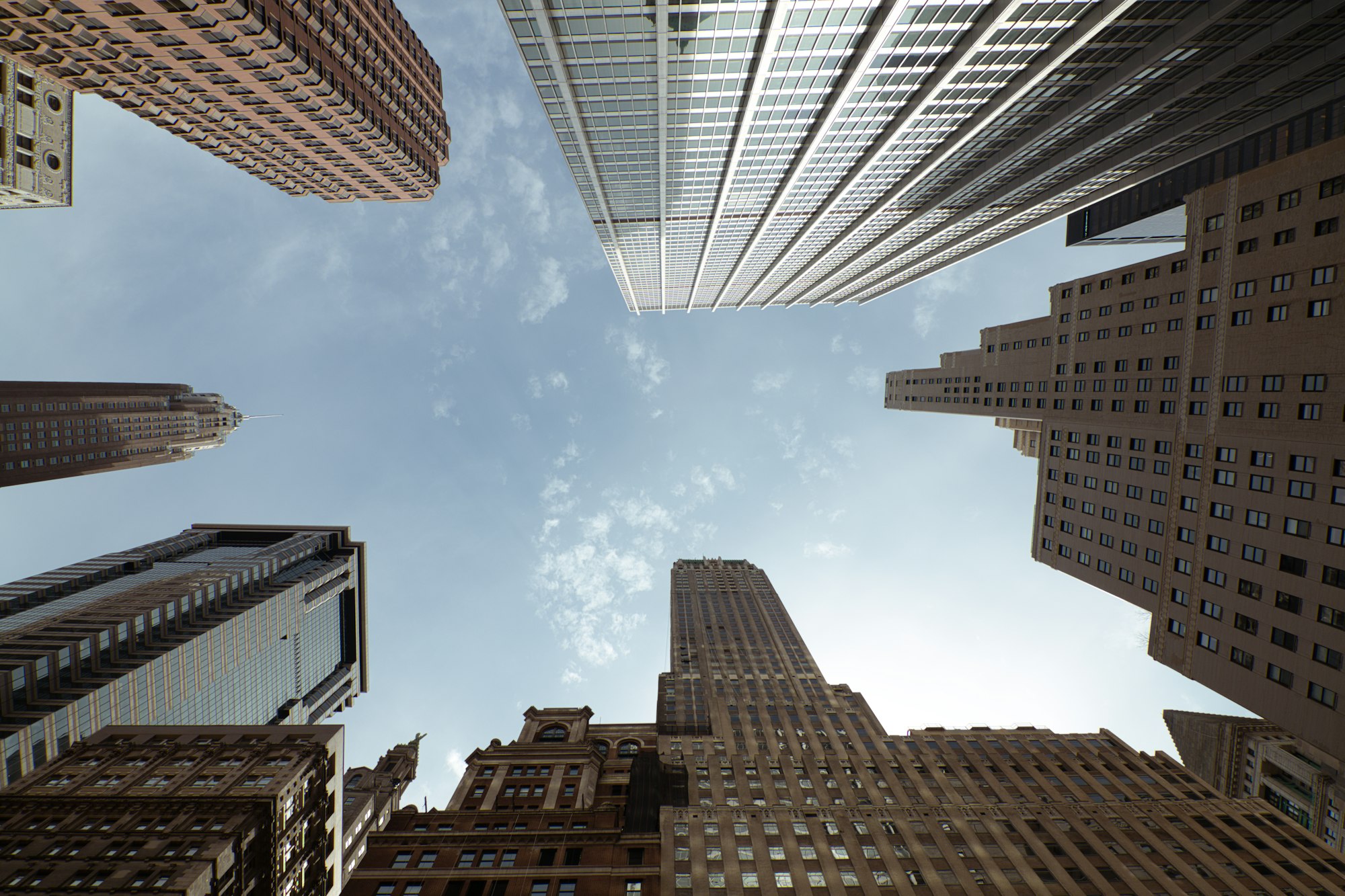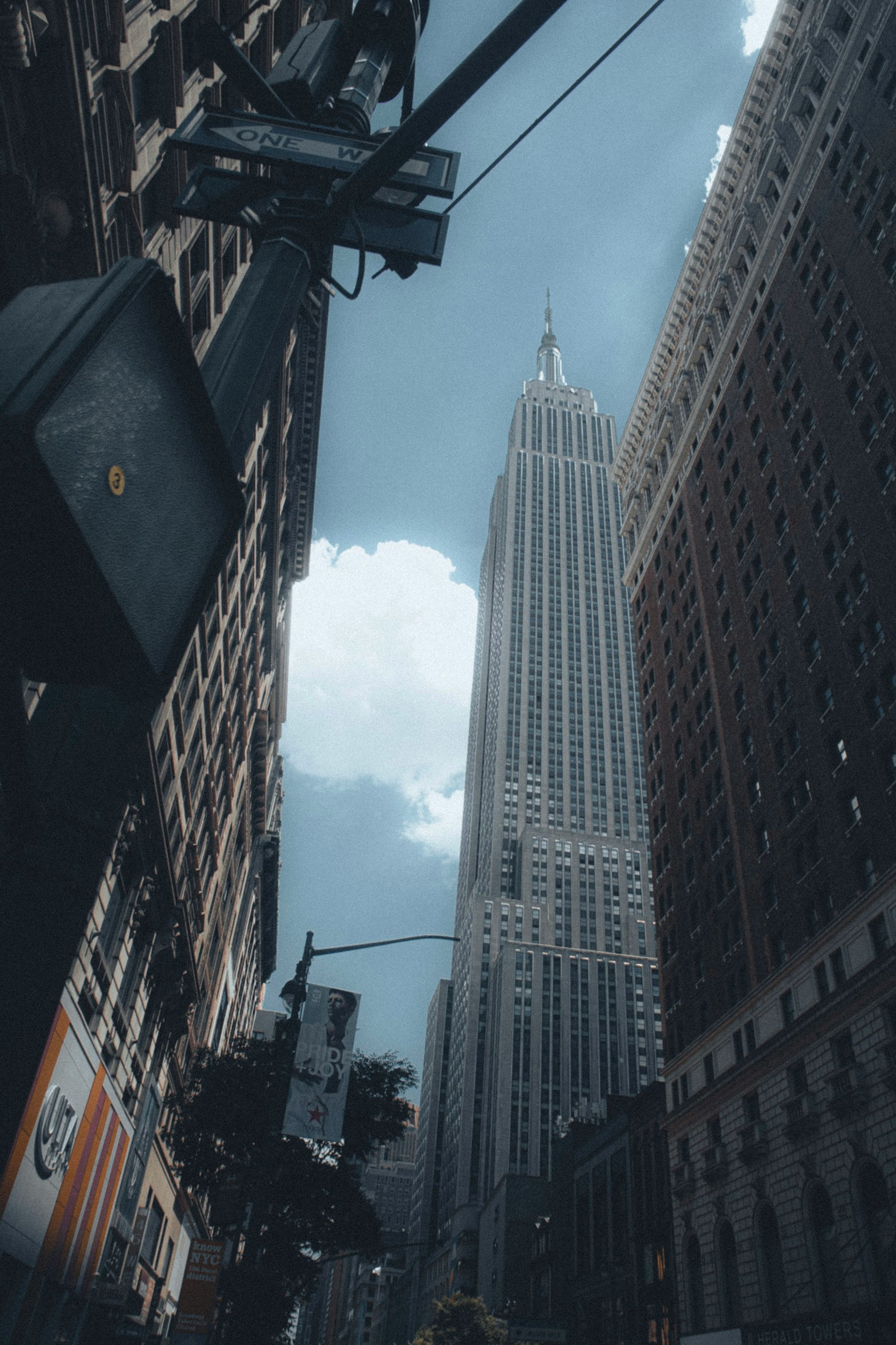Newbreak in the NYC Skyline: How Sustainable Architecture is Transforming the Big Apple

New York City: The name alone evokes images of towering skyscrapers, lights that never dim, and streets filled with the ceaseless hum of activity. The iconic metropolis, home to over eight million inhabitants, has long been a symbol of human ambition, with structures reaching ambitiously for the sky. But while the skyline tells a tale of architectural innovation and evolution, the narrative of the city's commitment to sustainability has been slower to emerge. As the world grapples with an escalating environmental crisis, the bustling urban giants are no longer just responsible for fostering commerce and culture; they must also spearhead the move towards sustainable living.
The need for sustainable solutions has never been more pressing. Cities, with their dense populations and industrial activities, contribute significantly to global emissions, waste production, and resource depletion. Environmental concerns have thus ceased to be just about preserving distant forests and oceans; they're about ensuring that our urban havens remain habitable for generations to come.
Enter the concept of "Newbreak" in the NYC skyline. This isn't just another towering monument to mankind's engineering prowess. Newbreak represents a transformative vision of what city living can, and should, be. Embodying the principles of sustainable architecture, Newbreak stands as an emblem of hope, a beacon illuminating the path forward for urban spaces everywhere. Through cutting-edge design and innovative solutions, the city that never sleeps is showing that it's not just awake, but also profoundly aware of its role in shaping a greener future.
As we dive deeper into the folds of this article, we'll explore the nuances of sustainable architecture, unveil the secrets behind Newbreak's innovative design, and witness how New York City is setting the pace in marrying architectural magnificence with ecological consciousness.
Transformation in Big Apple
New York City's skyline is an iconic vista that has undergone significant changes over the years, and this transformation is set to continue with the construction of ambitious skyscrapers. Some of the most anticipated projects include:
-
The Affirmation Tower: This is a proposed 1,633-feet-tall tower with a gravity-defying silhouette that would cantilever outwards from a multi-story base. The new construction would house two hotels, an observation deck, offices, and a skating rink.
-
One Vanderbilt: This is a commanding new skyscraper in the heart of Manhattan that is built to be especially climate-friendly. It pierces the sky like an inverted icicle and fuses seamlessly with an expanding network of trains and other transport at its foundation.
-
Empire State Building: This landmark building underwent an extensive and unprecedented retrofit a decade ago that saw it reworked top to bottom in an effort to save energy and reduce costs. New York State is now moving forward with a program called the Empire Building Challenge, which aims to encourage other building owners to follow the Empire State Building's example.
Architects have been asked to explain the shifting skyline of New York City, and some of them have expressed their likes and dislikes about the changes. The city's new laws will force dramatic changes in the design landscape, and landlords will be forced to look into an uncertain future and face stark choices. However, the changes are also an opportunity for sustainable architecture to transform the Big Apple's skyline, making it more environmentally friendly and energy-efficient. For instance, as buildings are updated, it becomes increasingly important to properly install your furnace for optimal energy performance and reduce emissions.
Citations:
[1] https://www.newsbreak.com/news/3159490418635-the-big-apple-is-getting-bigger-ambitious-skyline-defining-skyscrapers-are-set-to-change-nyc-s-iconic-vista-here-are-some-of-the-most-anticipated
[2] https://original.newsbreak.com/@new-york-city-explore-1632789/3149788930717
[3] https://www.insidehook.com/article/home-design/new-york-city-skyline-explained
[4] https://www.travelandleisure.com/culture-design/architecture-design/new-york-city-affirmation-tower-new-skyscraper
[5] https://www.nytimes.com/2023/02/14/climate/green-skyscraper-one-vanderbilt.html
[6] https://time.com/6026610/empire-state-building-green-retrofit/
nycLife - Newbreak NYC Skyline
The Importance of Sustainable Architecture
Significance in Reducing a City's Carbon Footprint
Sustainable architecture aims to reduce a building's entire carbon footprint, not just energy efficiency. Buildings are responsible for 39% of global carbon dioxide emissions. In New York City, buildings contribute 70% of greenhouse gas emissions, making sustainable designs essential in reducing the city's impact on climate change.
Key Statistics: Traditional vs. Sustainable
- Traditional buildings use materials such as cement, which contributes to around 8% of global CO2 emissions.
- Approximately 36% of global energy is consumed by buildings.
- In contrast, green buildings consume 25% less energy and 11% less water compared to traditional buildings.
By incorporating features like solar panels, wind turbines, and highly efficient insulation systems, sustainable buildings in NYC are setting a new standard for environmental responsibility.
Quality of Life for City Dwellers
But the benefits extend beyond mere numbers. The integration of natural elements into the design—such as green walls, natural lighting, and ventilation—significantly improves the well-being and mental health of its inhabitants. Sustainable architecture often emphasizes community spaces and pedestrian-friendly areas, thereby encouraging social interaction and community building. The use of non-toxic materials and improved air quality also contribute to fewer health issues among residents. In short, sustainable architecture aims to improve not just the city's environmental impact but also its social fabric.
Case Studies: Sustainable Landmarks in NYC
One Bryant Park
One Bryant Park, or the Bank of America Tower, is a LEED Platinum-certified skyscraper that uses sustainable technologies like water-saving fixtures and recycled materials.
The Vessel at Hudson Yards
Although not a building, this eye-catching structure is a testament to sustainable design. The Vessel is made from a tailor-made steel and bronze composite that not only reduces weight but also improves longevity, thus reducing the need for frequent repairs or replacements.
NYC is leading the way in sustainable architecture, prioritizing visually appealing and environmentally responsible designs for a greener future.
What Defines 'Sustainable Architecture'?
New York City, an ever-changing landscape of towering skyscrapers, brownstones, and iconic landmarks, has been facing a revolutionary change. Amidst the concrete jungle, a new breed of buildings is emerging that captivates the eye and lessens the ecological footprint. This transformation is driven by sustainable architecture, a burgeoning field that harmonizes the built environment with the natural world. From the Financial District to the Upper East Side, the skyline of NYC is experiencing a green overhaul. In this article, we delve into the core tenets of sustainable architecture and explore how these principles are metamorphosing the Big Apple's architectural tapestry.
Energy Efficiency
To achieve sustainable architecture, prioritize energy efficiency through natural light, ventilation, and renewable sources like solar and wind power. Use technologies like double-paned windows, smart sensors, and efficient HVAC systems to reduce energy consumption in buildings.
Renewable Materials
Choosing construction materials is pivotal in determining a building's sustainability quotient. Renewable materials such as bamboo, recycled steel, and eco-friendly insulation alternatives minimize the environmental impact and often offer superior durability and strength. Using these materials contributes to a reduced carbon footprint during construction and the building's lifetime.
Water Conservation
Water scarcity is a global issue, and sustainable architecture takes this challenge seriously. By incorporating systems like low-flow faucets, rainwater harvesting, and greywater recycling, sustainable buildings aim to minimize water wastage. These systems capture, treat, and reuse water for non-potable purposes like irrigation and toilet flushing, thus alleviating the pressure on municipal water supplies.
Waste Reduction
Another essential component of sustainable architecture is waste reduction. This goes beyond merely recycling materials and involves adopting design approaches that are adaptable and flexible. Buildings designed for disassembly allow for easy recycling and repurposing of materials if and when the structure is eventually taken down. This cradle-to-cradle approach focuses on the entire lifecycle of a building, ensuring that it leaves as minimal a waste footprint as possible.
Sustainable Architecture in NYC: Case Studies
The Edge at Hudson Yards
As one of the newest additions to the NYC skyline, The Edge at Hudson Yards is a beacon of sustainability. It incorporates a rainwater collection system to irrigate the green spaces around it, and using high-efficiency glass reduces energy costs. Its construction involved recycled materials, contributing to its LEED Gold certification.
One Bryant Park
Located in the heart of Manhattan, One Bryant Park is another shining example of sustainability. Its ice-cooling system significantly reduces electricity use, and it also features a 4.6-megawatt cogeneration plant that provides electricity and captures waste heat for reuse.
Sustainable architecture is vital for urbanization and environmentalism to coexist. New York City's focus on energy efficiency, renewable materials, water conservation, and waste reduction sets new standards for cities worldwide.
Latest Sustainable Architecture Projects in NYC
NYC is transforming environmental sustainability. Three innovative and groundbreaking sustainable architecture projects lead the charge in redefining the city's skyline and ethos.
Project 1: The Green Beacon
Overview of the project:
The Green Beacon is a 60-story mixed-use skyscraper located at the heart of Manhattan. Unlike traditional skyscrapers, this building focuses on integrating green spaces within the urban fabric. Designed by Greenline Architects, the tower features terraced gardens on every fifth floor and an expansive rooftop garden that offers breathtaking city views.
Sustainable features implemented:
- Rainwater harvesting systems to irrigate the terraced gardens.
- Solar panels on the façade and roof that power up to 30% of the building's energy needs.
- Passive heating and cooling mechanisms, reducing the need for artificial temperature control.
- Use of recycled construction materials and a waste management system that promotes recycling within the building.
The impact on the community and the environment:
The Green Beacon serves as a model for sustainable skyscraper design and promotes a sense of community. Its terraced gardens offer shared spaces for residents and office workers to interact. Environmentally, the building helps decrease the urban heat island effect and adds more green spaces, supporting local biodiversity.
Project 2: Hudson Eco-Hub
Overview of the project:
Located alongside the Hudson River, the Hudson Eco-Hub is an innovative project combining residential, commercial, and recreational spaces. At its core is a commitment to sustainable living, with spaces designed to foster community interactions and promote a greener lifestyle.
Sustainable features implemented:
- A tidal energy harvesting system that utilizes the Hudson River's currents to generate electricity.
- Vertical farms within the complex, producing organic vegetables and reducing the carbon footprint associated with the transportation of produce.
- Green roofs that insulate buildings, reducing heating and cooling needs.
- Efficient waste segregation and composting facilities.
The impact on the community and the environment:
Hudson Eco-Hub has transformed the way residents view urban living. With an on-site farm and energy system, it serves as a blueprint for self-sufficient communities. The vertical farms also offer educational opportunities for children and adults alike, promoting the concept of urban farming and local produce consumption.
Project 3: Solar Spiral Lofts
Overview of the project:
Nestled in Brooklyn, the Solar Spiral Lofts offer a fresh take on residential buildings. Its spiral design optimizes sunlight exposure, while the staggered balconies provide green spaces and gardens for each unit.
Sustainable features implemented:
- Solar-paneled exteriors that meet 50% of the building's energy demand.
- Graywater recycling system for watering plants and flushing toilets.
- Bicycle storage spaces to promote greener modes of transport.
- Use of sustainable construction materials and non-toxic paints and finishes.
The impact on the community and the environment:
Apart from being a visual marvel, the Solar Spiral Lofts create a micro-ecosystem that encourages residents to adopt a sustainable lifestyle. Providing individual gardens has boosted local biodiversity and fostered a deeper connection between residents and their environment. The project significantly reduces its carbon footprint by reducing energy consumption and promoting green transportation.
These projects are not just buildings but living, breathing examples of what the future of urban living can look like. They set a precedent for cities worldwide with an emphasis on sustainability, community, and harmony with nature. The new NYC skyline, thus, stands not just for architectural marvels but also for a sustainable vision of the future.
Other NYC Notable Projects
New York City has been at the forefront of green design and construction, with many eco-friendly buildings and developments in the works. Here are some of the latest sustainable architecture projects in NYC:
-
Perch Harlem: This is a new residential building in Harlem that features a green roof, solar panels, and energy-efficient appliances.
-
The Bank of America Tower: This is a LEED Platinum-certified skyscraper located at 1 Bryant Park, West 43rd Street. It features a host of sustainable features, including a rainwater harvesting system, a co-generation plant, and a green roof.
-
Magnusson Architecture and Planning (MAP): Since 1986, MAP has been designing award-winning green projects throughout New York City and the Hudson. Their projects include affordable housing, community centers, and schools.
-
The West on 11th Avenue: This is a new development in New York City that features a sustainable facade made with custom Truffle WasteBasedBricks® by StoneCycling. The facade is made from recycled materials and is designed to reduce the building's carbon footprint.
-
New York Police Academy: The new police academy in New York City is being built with a rainwater harvesting system that will help reduce water usage. The system will collect rainwater from the roof and use it for irrigation and other non-potable uses.
These are just a few examples of the many sustainable architecture projects happening in New York City. The city's commitment to green design and construction is helping to create a more environmentally friendly and sustainable future for all.
Citations:
[1] https://propertyclub.nyc/article/a-look-at-11-of-the-greenest-residential-buildings-in-nyc
[2] https://www.localize.city/blog/the-most-eco-friendly-buildings-in-nyc/
[3] https://www.propertyshark.com/Real-Estate-Reports/greenest-buildings-new-york-city/
[4] https://www.architectsnewyork.org/the-best-green-architects-in-new-york-city/
[5] https://www.6sqft.com/green-city-eight-of-the-biggest-eco-friendly-developments-happening-right-now-in-nyc/
[6] https://www.stonecycling.com/projects/sustainable-facade-the-west-new-york/
Leading a 'Newbreak' in City Living
New York City's skyline is changing with sustainable projects that redefine the city's architectural landscape. This movement, known as 'Newbreak,' represents a new wave of environmentally-friendly initiatives reshaping urban living. These projects are impacting city planning, real estate, and public perception.
A Shift in Evolution
The "Newbreak" is more than just a buzzword; it signifies a seismic shift in how New York City evolves. The sprawling metropolis, often criticized for its concrete jungles and high carbon footprint, is steadily becoming a haven for sustainable development. From Brooklyn's Passive Houses to Manhattan's LEED-certified skyscrapers, these projects reflect a change in ethos and sensibilities.
Today's architects are integrating solar panels, green roofs, and waste management systems into their designs. Public and private entities are investing in renewable energy projects and adopting resilient construction materials that can withstand the test of time—and climate change. The "Newbreak" is setting a standard for urban planning in NYC and globally, showcasing how cities can evolve into sustainable ecosystems without sacrificing their core characteristics.
Ripple Effects
City Planning
The success of these sustainable projects is altering the DNA of city planning in NYC. No longer are sustainability initiatives relegated to the periphery; they are now a central aspect of city planning. We are seeing more pedestrian-friendly spaces, vast public parks, and efficient public transport systems that reduce reliance on private vehicles. The city is also pushing for a circular economy, encouraging the reuse and recycling of materials in architectural projects.
Real Estate
Sustainability is now a prime factor in the real estate market. As eco-friendly designs become the norm, property values rise in areas where these green initiatives are concentrated. Real estate developers are noticing that sustainability isn't just a selling point but a necessary investment for future-proofing buildings. Whether retrofitting old constructions with modern sustainable technologies or building new structures from the ground up, the change is palpable and lucrative.
Public Perception
Perhaps the most remarkable ripple effect is the change in public perception. New Yorkers are starting to see their city as a hub of opportunity and a global leader in sustainable living. These architectural developments are visual reminders of what is achievable when innovation and sustainability go hand-in-hand. Additionally, they engender a sense of collective responsibility among residents to maintain and respect these shared spaces, creating a community bound by a common cause.
The "Newbreak" in New York City's skyline is a testament to human ingenuity and a commitment to a greener future. As this wave of sustainable architecture gains momentum, its influence extends beyond aesthetics and property values. It sets the stage for a comprehensive and harmonious coexistence of urbanity and sustainability, challenging other cities worldwide to adopt a new standard for what a modern city can—and should—be.
In essence, the New York City skyline isn't just growing; it's evolving, and in doing so, it offers a blueprint for the future of sustainable urban living.
Technology's Role in Sustainable Architecture
New York City, often described as the city that never sleeps, is witnessing a transformative architectural period that marries innovation with sustainability. Known for its iconic skyline—a blend of historical landmarks and towering skyscrapers—the Big Apple is fast embracing a future where buildings define the skyline and the city's commitment to environmental stewardship.
From energy-efficient glass that maximizes natural light to vertical gardens that offer aesthetic beauty and a carbon sink, New York City's structures are not just about grandeur anymore; they're about sustainability. In this context, technology plays an indispensable role.
How modern technology is aiding in the development and implementation of sustainable solutions
Advancements in technology have been instrumental in pushing the boundaries of sustainable architecture. Software tools like Building Information Modeling (BIM) allow architects to virtually simulate energy consumption and airflow in designs before they're built. This makes integrating features like passive solar heating and natural ventilation easier from the get-go, resulting in highly optimized buildings that minimize energy usage and reduce carbon footprints.
Moreover, material science has made remarkable strides in creating sustainable building materials, such as self-cleaning concrete that purifies the air or solar glass that can convert sunlight into energy. Technologies like 3D printing enable intricate designs that maximize space usage and energy efficiency without increasing construction waste.
Case studies or examples where technology services have contributed to sustainability
-
The Edge in Amsterdam as a Learning Point for NYC: One of the world's most sustainable office buildings, The Edge uses a range of sensors connected to a central dashboard that continuously analyzes building performance. Light and temperature are adjusted in real-time, maximizing comfort and energy efficiency. Many buildings in NYC are now adopting similar intelligent building systems.
-
One Bryant Park, New York: Also known as the Bank of America Tower, this structure is renowned for its ice-cooled air conditioning system and water reuse strategies. Advanced technology helps monitor water and energy use in real-time, allowing instant adjustments.
-
VIA 57 West, New York: Known for its striking pyramid-like shape, VIA 57 West employs a central courtyard as a natural ventilation funnel, drastically reducing the need for artificial heating and cooling. BIM was extensively used in its design phase to perfect this architectural marvel's sustainability features.
-
Javits Center's Green Roof: This expansive convention center in New York has one of the largest green roofs in the U.S., covering nearly seven acres. Aside from providing natural insulation and lowering energy costs, the roof has become a wildlife sanctuary—data analytics help monitor its impact on local biodiversity and energy savings.
-
Sidewalk Labs' Quayside Project: Although this Google affiliate's project is centered in Toronto, its concepts influence NYC developments. From heated sidewalks that melt snow to trash cans that signal when they're full, technology is being used to streamline municipal functions to reduce energy expenditure and increase efficiency.
Modern architecture is embracing technology and sustainability to create innovative and eco-friendly skyscrapers. New York City's changing skyline represents how cities can contribute to a sustainable future for the planet. The Big Apple is just the beginning.
The Rise of Green Buildings
New York City, the iconic hub of skyscrapers, Broadway, and the American dream, is no stranger to transformations. From its bustling financial districts to its quiet brownstone-lined neighborhoods, NYC has continually evolved to adapt to modern times. One of the latest—and perhaps most crucial—changes is the city's shift towards sustainable architecture.
Recent years have witnessed the Big Apple leaning green, with new projects like the Hudson Yards complex and retrofitting older buildings like the Empire State Building to meet LEED (Leadership in Energy and Environmental Design) standards. These structures incorporate energy-efficient heating and cooling systems, rooftop gardens, and vertical farms.
The Importance of Sustainable Architecture
The benefits are twofold: sustainable architecture minimizes the ecological footprint and saves money in the long term by reducing energy costs. Furthermore, these green innovations help combat the urban heat island effect, which makes cities like New York significantly warmer than their surrounding areas.
Challenges and Future Directions
Challenges Facing Adoption
Despite its growing momentum, sustainable architecture in NYC faces several challenges:
-
High Initial Costs: The upfront cost of green technologies can be steep, deterring investment from developers and property owners.
-
Regulatory Hurdles: While New York has been progressive in environmental policy, the bureaucratic tape around building codes can make it difficult for new projects.
-
Lack of Awareness: Only some understand the long-term advantages of sustainable design, often seeing it as a trendy buzzword rather than a necessity.
-
Scalability and Replicability: Many successful green buildings are large-scale projects backed by substantial funding. There's a need for scalable solutions for smaller structures and less affluent communities.
-
Technological Gaps: Current technology still has limitations in efficiency and affordability, which need to be addressed for widespread adoption.
Policy Recommendations and Future Projects
To overcome these obstacles, several initiatives and policies could be put into place:
-
Financial Incentives: Tax breaks and subsidies for green construction can make these projects more financially attractive.
-
Streamlined Regulations: Simplifying the approval process for sustainable structures would ease the pathway for more green buildings.
-
Public Awareness Campaigns: City-wide campaigns educating people on the benefits of sustainable architecture can spur consumer demand for greener buildings.
-
Open Source Solutions: Encourage sharing successful architectural plans and strategies so they can be easily replicated in diverse settings.
-
R&D Investment: Significant funding in research and development can accelerate technological advancements needed to make green buildings the norm rather than the exception.
Several future projects are in the pipeline, such as the much-anticipated Solar Carve Tower along the High Line, designed to maximize solar gain and reduce shadows on the surrounding area. Another exciting initiative is the Brooklyn Naval Yard's transformation into a modern manufacturing facility with sustainability at its core.
The New York skyline is an ever-evolving marvel of human innovation. By committing to sustainable architecture, the city is setting itself up for aesthetic transformations and a more sustainable, efficient, and livable urban environment. While challenges exist, the road ahead is filled with the promise of green towers rising amidst the concrete jungle, offering a cleaner, greener future for all New Yorkers.
Conclusion
The Old Vs. The New
NYC's skyline has been a canvas for architects for generations. The Empire State and Chrysler buildings symbolize human ambition but weren't built sustainably. Bank of America Tower and One Bryant Park are part of a new generation of buildings prioritizing sustainability.
Key Elements of Sustainable Architecture
Sustainable architecture involves considering all stages of a building's life, from design to decommissioning. Features like green roofs and rainwater harvesting systems are often incorporated into designs. Local Law 97 in NYC sets greenhouse gas reduction targets for larger buildings.
Community Benefits
The benefits of sustainable architecture are not restricted to environmental conservation alone. These buildings provide better living and working conditions, improving health and well-being. New developments are also often integrated with public transport systems, reducing the need for cars and reducing air pollution and traffic congestion.
Economic Impacts
While the initial costs of sustainable construction might be higher, the long-term savings are considerable. Reduced energy consumption lowers utility bills, and many buildings are eligible for tax benefits and incentives. Moreover, as demand for eco-friendly real estate grows, property values for sustainable buildings are set to increase, making it a smart investment for the future.
New York City's changing skyline reflects our evolving values and priorities, including the urgent need for sustainable architecture. These eco-friendly designs set a precedent for all new buildings, addressing the challenges of climate change and limited resources. Anyone can help drive this transformation by advocating for sustainable policies, investing in eco-friendly real estate, or being more aware of their environmental impact. We can create a future where cities are both larger and more sustainable.







Comments ()